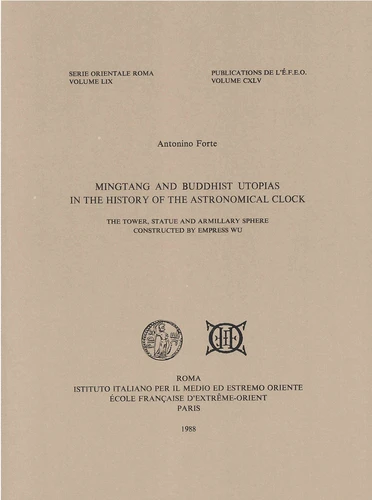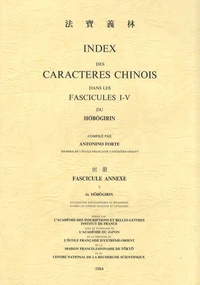Mingtang and buddhist utopias in the history of the astronomical clock. The tower, statue and armillary sphere constructed by Empress Wu
Par :Formats :
- Réservation en ligne avec paiement en magasin :
- Indisponible pour réserver et payer en magasin
- Nombre de pages342
- PrésentationBroché
- Poids0.68 kg
- Dimensions18,6 cm × 25,6 cm × 1,5 cm
- ISBN2-85539-745-6
- EAN9782855397450
- Date de parution31/12/1988
- CollectionPublications de l'École frança
- ÉditeurEFEO
Résumé
This book has its origins in research which I began in Autumn 1982 in an attempt to understand the nature of an obscure Buddhist building called "celestial hall" or "heavenly mansion" (tiantang). This building was erected in the palatine city of Luoyang in the year 689 A. D. As sometimes happens, when you look for one thing, you find other things which are even more interesting ; at a certain point my research, I thus found myself pursuing a path which I never would have predicted...
Antonino Forte Table of content Preface Introductory essay : The clock and the perfect society 1. The Chinese clock and the European clock 2 The great regulator of Wu Zhao 3. The importance of time for the Chinese Buddhist Appendix : On the transmission of the text of Daoxuan on the Jetevana Monastery Chapter one : The tower, the statue, the armillary sphere 1. The great armillary sphere (Day 1) 2.
The tower called Tiantang i. Historical Events ii. Size and architecture of the tiantang 3. The Great Statue (Daxiang) Appendix : Matsumoto Bunzaburo confusion of the great lacquer statue with the great bronze statue on the Bai Sima slope Chapter two : The origins of the mechanical clock 1. The Tiantang interpreted as a `sacred tower' 2. The mystique of the Lingtai 3. The Dayi and the origin of the mechanical clock Appendix A : Notes on some great towers prior to the tiantang and their possible relation with the idea of lingtai Appendix B : Yamada Keiji's opinion on the meaning of dayi Chapter three : The two mingtang compared 1.
The dates of the two Mingtang 2. Size and architecture of the two Mingtang 3. The abortive attempt to reconstruct the Mingtang 4. Hypothesis on the first Mingtang Appendix A : The paths followed by historians to eject the tiantang from the mingtang Appendix B : The eleven missing characters in the current editions of the Zizhi tongijian Chapter four : Some remarks on the social context 1. The Mingtang as an architectural projection of different politico-religious conceptions 2.
The fertile soil of Maitreyan utopianism 3. The Mingtang/Clock-Buddhism/Pacifism association Conclusion Summary of three attempts to construct The Mingtang at Luoyang Bibliography General index Illustrations
Antonino Forte Table of content Preface Introductory essay : The clock and the perfect society 1. The Chinese clock and the European clock 2 The great regulator of Wu Zhao 3. The importance of time for the Chinese Buddhist Appendix : On the transmission of the text of Daoxuan on the Jetevana Monastery Chapter one : The tower, the statue, the armillary sphere 1. The great armillary sphere (Day 1) 2.
The tower called Tiantang i. Historical Events ii. Size and architecture of the tiantang 3. The Great Statue (Daxiang) Appendix : Matsumoto Bunzaburo confusion of the great lacquer statue with the great bronze statue on the Bai Sima slope Chapter two : The origins of the mechanical clock 1. The Tiantang interpreted as a `sacred tower' 2. The mystique of the Lingtai 3. The Dayi and the origin of the mechanical clock Appendix A : Notes on some great towers prior to the tiantang and their possible relation with the idea of lingtai Appendix B : Yamada Keiji's opinion on the meaning of dayi Chapter three : The two mingtang compared 1.
The dates of the two Mingtang 2. Size and architecture of the two Mingtang 3. The abortive attempt to reconstruct the Mingtang 4. Hypothesis on the first Mingtang Appendix A : The paths followed by historians to eject the tiantang from the mingtang Appendix B : The eleven missing characters in the current editions of the Zizhi tongijian Chapter four : Some remarks on the social context 1. The Mingtang as an architectural projection of different politico-religious conceptions 2.
The fertile soil of Maitreyan utopianism 3. The Mingtang/Clock-Buddhism/Pacifism association Conclusion Summary of three attempts to construct The Mingtang at Luoyang Bibliography General index Illustrations
This book has its origins in research which I began in Autumn 1982 in an attempt to understand the nature of an obscure Buddhist building called "celestial hall" or "heavenly mansion" (tiantang). This building was erected in the palatine city of Luoyang in the year 689 A. D. As sometimes happens, when you look for one thing, you find other things which are even more interesting ; at a certain point my research, I thus found myself pursuing a path which I never would have predicted...
Antonino Forte Table of content Preface Introductory essay : The clock and the perfect society 1. The Chinese clock and the European clock 2 The great regulator of Wu Zhao 3. The importance of time for the Chinese Buddhist Appendix : On the transmission of the text of Daoxuan on the Jetevana Monastery Chapter one : The tower, the statue, the armillary sphere 1. The great armillary sphere (Day 1) 2.
The tower called Tiantang i. Historical Events ii. Size and architecture of the tiantang 3. The Great Statue (Daxiang) Appendix : Matsumoto Bunzaburo confusion of the great lacquer statue with the great bronze statue on the Bai Sima slope Chapter two : The origins of the mechanical clock 1. The Tiantang interpreted as a `sacred tower' 2. The mystique of the Lingtai 3. The Dayi and the origin of the mechanical clock Appendix A : Notes on some great towers prior to the tiantang and their possible relation with the idea of lingtai Appendix B : Yamada Keiji's opinion on the meaning of dayi Chapter three : The two mingtang compared 1.
The dates of the two Mingtang 2. Size and architecture of the two Mingtang 3. The abortive attempt to reconstruct the Mingtang 4. Hypothesis on the first Mingtang Appendix A : The paths followed by historians to eject the tiantang from the mingtang Appendix B : The eleven missing characters in the current editions of the Zizhi tongijian Chapter four : Some remarks on the social context 1. The Mingtang as an architectural projection of different politico-religious conceptions 2.
The fertile soil of Maitreyan utopianism 3. The Mingtang/Clock-Buddhism/Pacifism association Conclusion Summary of three attempts to construct The Mingtang at Luoyang Bibliography General index Illustrations
Antonino Forte Table of content Preface Introductory essay : The clock and the perfect society 1. The Chinese clock and the European clock 2 The great regulator of Wu Zhao 3. The importance of time for the Chinese Buddhist Appendix : On the transmission of the text of Daoxuan on the Jetevana Monastery Chapter one : The tower, the statue, the armillary sphere 1. The great armillary sphere (Day 1) 2.
The tower called Tiantang i. Historical Events ii. Size and architecture of the tiantang 3. The Great Statue (Daxiang) Appendix : Matsumoto Bunzaburo confusion of the great lacquer statue with the great bronze statue on the Bai Sima slope Chapter two : The origins of the mechanical clock 1. The Tiantang interpreted as a `sacred tower' 2. The mystique of the Lingtai 3. The Dayi and the origin of the mechanical clock Appendix A : Notes on some great towers prior to the tiantang and their possible relation with the idea of lingtai Appendix B : Yamada Keiji's opinion on the meaning of dayi Chapter three : The two mingtang compared 1.
The dates of the two Mingtang 2. Size and architecture of the two Mingtang 3. The abortive attempt to reconstruct the Mingtang 4. Hypothesis on the first Mingtang Appendix A : The paths followed by historians to eject the tiantang from the mingtang Appendix B : The eleven missing characters in the current editions of the Zizhi tongijian Chapter four : Some remarks on the social context 1. The Mingtang as an architectural projection of different politico-religious conceptions 2.
The fertile soil of Maitreyan utopianism 3. The Mingtang/Clock-Buddhism/Pacifism association Conclusion Summary of three attempts to construct The Mingtang at Luoyang Bibliography General index Illustrations


